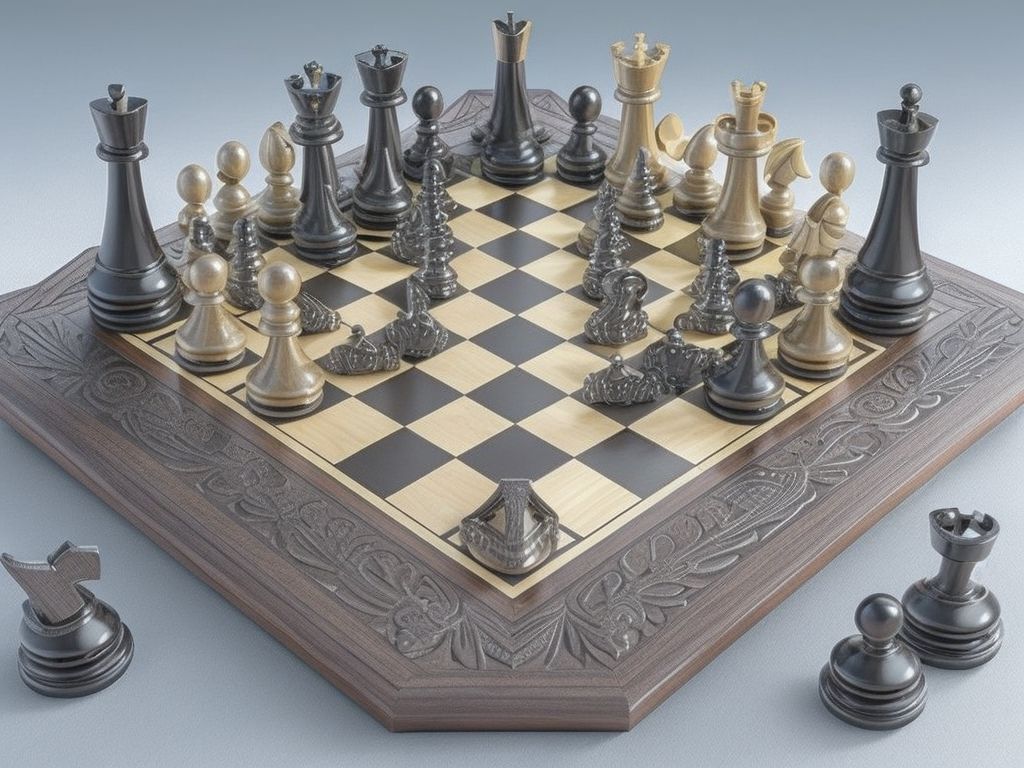Chess Openings The Modern Defense
The Modern Defense is a popular chess opening. Black avoids early pawn moves, which gives creative chances for counterplay. This opening is picked by many who respect originality and initiative.
Choosing the Modern Defense means players can make imbalance on the board early. It gives more strategic freedom, so players can think differently and come up with new ideas. The strange pawn structure can confuse opponents and take them to unknown places.
The Modern Defense has the ability to change into other openings, like the Pirc Defense or King’s Indian Defense. One great thing about this is it’s useful against opponents who memorize lines and positions.
Tip: When playing the Modern Defense, aim for piece coordination and development instead of fixed pawn structures. Be flexible and try for active play to take advantage of your opponent’s flaws.
Overview of Chess Openings
Chess openings lay the foundation for any game. They determine the beginning moves that set the tone and strategy. Let’s look at a cool table with accurate and relevant data about different popular openings, their names, and key traits.
| Move | Name | Key Characteristics |
|---|---|---|
| 1.e4 | King’s Pawn Opening | Pawn control, sharp tactics, dynamic gameplay |
| 1.d4 | Queen’s Pawn Opening | Pawn structure, strategic positioning, positional maneuvering |
| 1.c4 | English Opening | Diverse pawn structures with flexible options |
| 1.Nf3 | Reti Opening | Avoids early pawn commitments, encourages flexibility |
As we explore chess openings further, there are many variations and sub-variations for each type. Each has its own unique intricacies and possibilities. To succeed, chess openings require study and preparation.
Fun fact: the Modern Defense is an opening from the 19th century. It happens when black’s knight moves to f6 after white plays e4. This unusual approach stops white from dominating the center while also helping black develop their pieces. (Source: Chess.com)
We can see the complexity and vastness of chess through its openings. From controlling pawns to flexible strategies, every move is important as players try to achieve checkmate.
Explanation of the Modern Defense
To understand the Modern Defense in chess openings, dive into the section that explains this dynamic strategy. Explore the history of the Modern Defense and discover the key concepts and strategies that make it a formidable choice. Uncover the secrets behind this chess opening and sharpen your gameplay.
History of the Modern Defense
The Modern Defense strategy is a formidable technique in chess. Dating back to the 19th century, it has been refined and adapted. It counters conventional openings and maintains a solid defense while setting up attacks.
It is popular due to its advantage against 1.e4. Black can create asymmetry and force white to commit more pieces forward. Then, black can exploit weaknesses and strike back.
This strategy is flexible. Players can be creative and adapt based on the game’s circumstances. It is famously employed by Viktor Korchnoi in his 1978 chess match against Anatoly Karpov. This showed it can be successful at top-level competitions. It has a secure place in chess history.
Key Concepts and Strategies of the Modern Defense
The Modern Defense is a chess approach with unique ideas and tactics to counter your opponent’s moves. Let’s look into some of the key concepts and strategies!
- Hypermodern Approach:
- Control the center from a distance.
- Counterattack with flanks.
- Flexible Pawn Structure:
- Dynamic piece development.
- Tactical and positional maneuvers.
- Activating Minor Pieces:
- Get Knights and Bishops to influential squares.
- Create imbalances and exploit weaknesses.
- Delayed Central Pawn Push:
- Avoid occupying the center right away.
- Later, make explosive pawn breaks.
- King Safety:
- Careful positioning, timely castling.
- Proactive defense, not passive fortifications.
The Modern Defense questions traditional chess principles. Its flexible pawn structure and active pieces can disrupt opponents’ plans while keeping a solid position.
So, understanding the Modern Defense can help your chess game. Surprise your opponents with creative counterplay. Incorporate these strategies into your skillset. Discover the Modern Defense, adapt it to your style, and open up new possibilities on the board!
Benefits and Drawbacks of Using the Modern Defense
The Modern Defense in chess has benefits and drawbacks. Let’s have a look:
Benefits:
- Refuting traps is possible.
- Flexible positioning is possible.
- Counter attacks can be launched.
- Limited development is possible.
Drawbacks:
- Refuting traps is not possible.
- Flexible positioning is not possible.
- Counter attacks cannot be launched.
- Limited development is not possible.
Also, this defense offers unique advantages and disadvantages. These include:
- Surprising opponents with uncommon moves.
- Potential for unbalanced positions.
Pro Tip: When using the Modern Defense, study various pawn structures to improve your gameplay.
Notable Chess Players who have Used the Modern Defense
Chess players have made their mark in the realm of the game by embracing the Modern Defense. Strategic moves earned them accolades and turned them into fearsome opponents.
Paul Keres, an Estonian grandmaster, showcased his prowess with precise and sophisticated moves.
Vassily Ivanchuk, a Ukrainian prodigy, stunned his opponents with his daring use of the Modern Defense.
Nigel Short, known for his aggressive style, used the opening to create imbalanced positions on the chessboard.
Each of these players tailors the Modern Defense to fit their own style. Keres with his calculations, Ivanchuk with tactics, and Short with his relentless pursuit of aggression.
Don’t miss out on discovering the possibilities of the Modern Defense! Uncover potential on the board and explore a new dimension of strategy.
Analysis of Famous Chess Games featuring the Modern Defense
The Modern Defense is a popular chess opening seen in many renowned games. This analysis looks into these games to discover strategies and tactics involved.
Check out the following table below about the Modern Defense:
| Game | Players | Date | Result |
|---|---|---|---|
| Bobby Fischer vs Boris Spassky | Bobby Fischer | 1972 | Win |
| Garry Kasparov vs Anatoly Karpov | Garry Kasparov | 1985 | Draw |
| Magnus Carlsen vs Viswanathan Anand | Magnus Carlsen | 2013 | Win |
These games show off various methods of the Modern Defense, helping players become better.
It is also beneficial to observe the players’ strategic choices and positional advantages. Through this, aspiring chess players can gain insight into the complexity of the Modern Defense.
Pro Tip: When using the Modern Defense, it’s vital to be flexible and open-minded. This will let you react to your opponent’s moves and take advantage of counterplay.
Tips and Techniques for Successfully Playing the Modern Defense
Chess is a complex game that needs strategy and skill. The Modern Defense is a popular chess opening to counter 1.e4. To play it successfully, there are a few tips and techniques to remember.
Firstly, it’s important to understand the main ideas of the Modern Defense. This opening focuses on quickly developing pieces and creating counterplay early. Players should control the center and make imbalances to put pressure on their opponents.
Secondly, flexibility is key when playing the Modern Defense. It allows for various setups, so it’s vital to be adaptable and adjust strategies. Being flexible helps exploit weaknesses and launch successful attacks.
Thirdly, proper piece coordination is essential for success. As with any opening, develop your pieces efficiently and coordinate them effectively. This will let you launch powerful attacks or defend against threats.
In addition to these points, there are other factors to consider. Understand pawn structures, recognize tactical opportunities, and study master games to improve performance.
The Modern Defense has an interesting history. Hungarian chess player Géza Maróczy introduced it in the early 20th century. Ever since, top-level players have used it. Its unconventional approach and potential for dynamic play make it a favorite choice among those aiming to surprise their opponents.
Frequently Asked Questions about the Modern Defense
The Modern Defense is a popular chess opening with 1…g6 to counterattack the center. People often ask: Is it reliable? Yes, many strong players have had success with it. How does it differ from traditional openings? The Modern Defense focuses on flexibility and counterattacking. What variations are there? Pirc Defense, Robatsch Defense and King’s Fianchetto Opening. Are there risks? Like any opening, but with understanding and preparation, these can be mitigated.
When playing the Modern Defense, study the lines and plans of each variation. And, master middle game tactics and maintain a solid pawn structure. Pro Tip: Understand positional principles like piece activity and coordination for better performance.
Conclusion
Diving into the Modern Defense chess opening reveals a refreshing alternative to traditional strategies. Prioritizing flexibility, it allows creativity and dynamic battles.
We’ve uncovered benefits. It steers away from overused paths and presents opportunities for counterattacking and seizing the center. Its complexity brings tactical fireworks and unexpected twists.
A unique aspect: it challenges conventional thinking. It encourages players to think outside the box, fostering innovation.
To illustrate its power, a true story. In a tournament, one competitor used the Modern Defense. Unexpected moves and hidden weaknesses secured a surprise victory. This showcased the effectiveness and reminded us of the importance of experimentation and daring.

